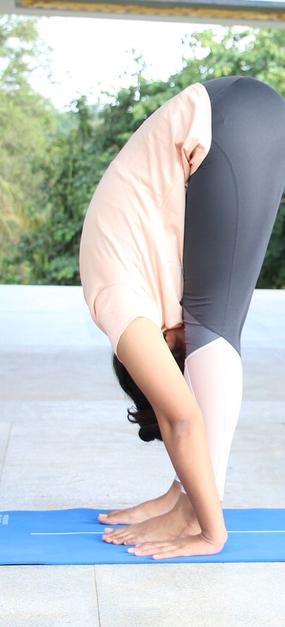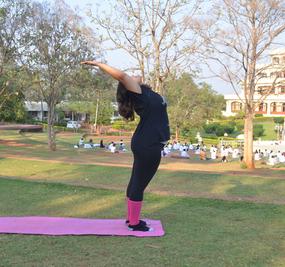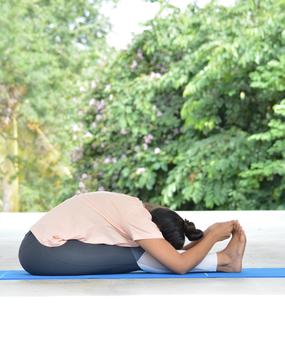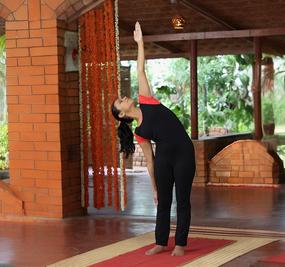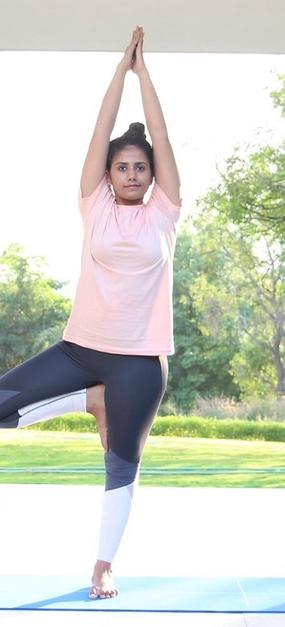How to do Prasarita Padahastasana
- Stand erect with your feet 3-4 feet apart, balanced and firmly grounded. Breathe gentle deep breaths.
- Inhale, lengthen the spine, stretch arms overhead.
- Exhale, bend forward from the hip joints, keeping the spine straight.
- Place hands on the floor, under the shoulders. Inhale, exhale gentle deep breaths.
- Lifting the hips up, bend further as you breath out to bring the head toward the floor in between the hands.
- Separate the thighs. If you are stable, you can separate your feet further apart, maintaining the balance and firmness.
- Breathing out, press your hands firmly on the floor to deepen the bend. If your hands reach the feet, get hold of your big toes and pull on them to get a deeper bend.
- Inhale, stretch the arms to the front and lift upslowly.
- Exhale, bring the arms to the sides.
Benefits of the Prasarita Padahastasana
- Strengthens the legs and feet.
- Lengthens the spine.
- Stretches the hamstrings.
- Strengthens the abdomen.
Contraindications
People suffering from lower back pain should avoid stretching to the fullest as it might aggregate the condition.
All Yoga PosesPrevious yoga pose: Veerabhadrasana
Next yoga pose: Vrikshasana
FAQ’s about Prasarita Padahastasana (Standing Forward Bend)
Benefits of Prasarita Padahastasana: It strengthens the legs and feet. It lengthens the spine. It stretches the hamstrings. It strengthens the abdomen and joints.
Benefits of Padahastasana: It alleviates flatulence and constipation. It improves the concentration, metabolism, and digestive system. It strengthens the legs and feet. It lengthens the spine. It stretches the hamstrings. It strengthens the abdomen and joints.
Wide-Legged Forward Bend — Prasarita Padahastasana (Prah-sah-REET-ah- Pah-doh-tahn-AA-SUN-aa) — is an energizing inversion that increases circulation to the brain while providing a deep stretch for the legs, back and arms.
In Paschimottanasana, you place your hands on your legs, wherever they reach, without forcing. If you can, take hold of your toes and pull on them to help you go forward. But in Padahastasana, you are ideally required to place your hands under your feet.
People suffering from lower back pain should avoid stretching the maximum as it aggravates the condition.
Yes, Prasarita Padottanasana is a hip opener as the asana involves opening up the legs. All the asanas in which feet are wide apart are easier for opening the hips. The name of the asana also suggests that Prasarita, meaning outstretched, pada, meaning foot, ut, meaning intense, tan, meaning to stretch or extend, and asana, meaning pose.
Stand erect with your feet 3-4 feet apart, balanced, and firmly grounded. Inhale, lengthen the spine, stretch arms overhead. Exhale and bend forward from the hip joints, keeping the spine straight. Place hands on the floor, under the shoulders. Inhale, exhale gentle deep breaths. Lifting the hips up, bend further as you breathe out to bring the head toward the floor in between the hands. Separate the thighs. If you are stable, you can separate your feet further apart, maintaining balance and firmness. Breathing out, press your hands firmly on the floor to deepen the bend. If your hands reach the feet, get hold of your big toes and pull on them to get a deeper bend. Inhale, stretch the arms to the front and lift up slowly. Exhale, bring the arms to the sides.
Stand straight and tall with your feet close to each other. Inhale and stretch both your arms above your head. Feel the stretch in your back and arms. Exhale and bend forward to bring your stretched arms down. Bring your head as much as possible closer to your knees. Either grip your calves with your hands or tuck your hands under your foot. You can initially bend your knees while you are gripping your foot. Later, slowly and gradually, straighten your knees. Do not force. Breathe a few times. Release the grip of your hands while inhaling and coming up.
Padahastasana is a standing forward bend. It is one of the 12 basic postures of Hatha yoga. It is the third pose of Surya Namaskar or Sun Salutation. The name comes from the Sanskrit pada means “foot,” hasta means “hand” and asana means a “seat” or “posture”.
The contraindications of Padahastasana are: Avoid the asana if you have undergone surgery or have an injured neck, spine, shoulder, hips, or knee.
With each inhale, pull your heels in Padahastasana. With each exhale, squeeze your tummy so that your head is closest to your knees. Initially, practice gripping your calf muscles with your hand. Gradually you can tuck your hands under your feet. Lengthen your spine to the max to open up your upper spine.



